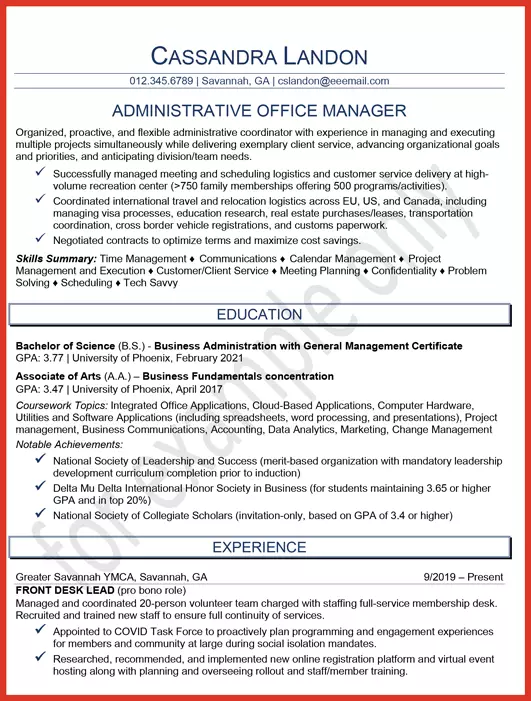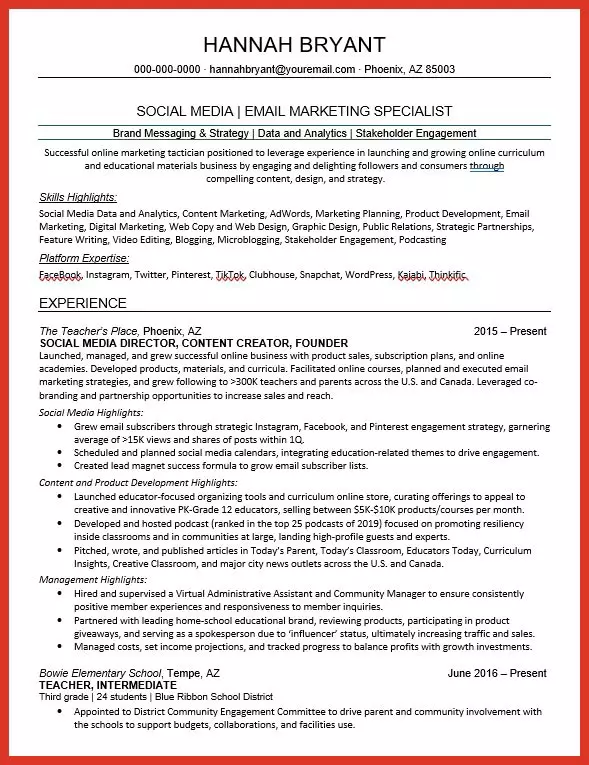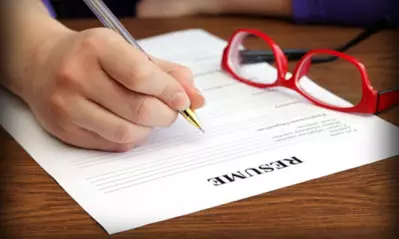How to write a resumé, with samples
This article was updated on December 4, 2023.
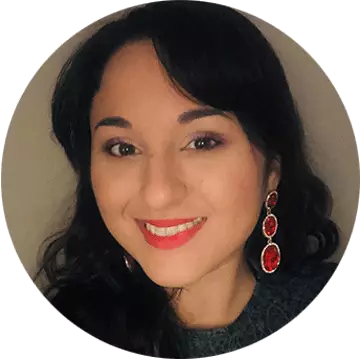
Written by Lilia Ortiz

Reviewed by Jessica Roper, MBA, director of Career Services at University of Phoenix

Knowing how to write a resumé that showcases your skills and experience is the foundation to any successful job search. Of course, this is easier said than done, especially if it’s your first time writing one. In this article, you learn more about writing a resume, get resume templates and tools to download.
How to write an effective resumé
Are you nervous about the thought of sitting down to write a resumé? A blank page can admittedly be intimidating. Never fear! When it comes down to it, writing a resumé is simply about highlighting your qualifications while keeping in mind who, or what, will be reading it, which often includes both people and computers, or an applicant tracking system (ATS).
Before taking a look at these resumé examples, here are a few tips for writing your own effective resumés, no matter where you are in your career journey. You can also pick up resume writing tips in this resume guide .
Five steps to write a resumé
1. Identify your audience

Remember that part above about knowing your audience? That’s the first step. Before you even touch your keyboard, you’ll need to establish your focus. Use tools like LinkedIn or Indeed to search for jobs you’re interested in and would like to apply for. Having a LinkedIn Profile, specifically, is a fantastic way of reaching out directly to a hiring manager or recruiter. The more people you know, the better!
After you find a job description that sounds like a good fit, make sure to read it several times to understand exactly what skills the employer and the ATS are searching for. Look for keywords specific to your industry and, if they’re relevant to your experience, include those in your resumé.
While it may seem tedious at first, the best way to get your foot in the door is by matching what recruiters are looking for and emphasize it. If you have relevant work experience, it’s a no-brainer to take the extra steps. It also has the added benefit of showing recruiters and hiring managers that you’re detail-oriented and willing to put in the work to be noticed.
A word of caution: It might be tempting to use a one-size-fits-all resumé to mass apply and save some time, but that can hurt rather than help you. Instead, tailor your resumé to suit the specific job you’re applying for by using relevant keywords to explain why you’re uniquely qualified for the position.
Ideally, your skills section, work history, and previous job titles will closely align with the job description. However, hiring managers and human resources know that job seekers come from a variety of backgrounds so don’t be discouraged if your qualifications don’t align perfectly.

A resumé should be easy to scan in seconds. That means an outline is essential, and keeping the most important parts at the top is imperative. Your resumé should have headers such as “Qualifications,” “Experience,” and “Education.” The headers will vary, however, based on your experience and the industry you’re in.
Now comes the fun part: choosing your resumé’s design! You can find a wide range of resumé design options online or in Microsoft Word. You can also hire a designer to spiffy up your resumé, but be aware that some applicant tracking systems are sensitive to certain formats and may reject a resumé if they can’t “read” it. So make sure you’re looking for ATS-friendly designs.
To create an effective resumé, make sure to pick a design that’s uncluttered and easy to read. Here are some key tips:
- Avoid the Comic Sans font. Period.
- Instead, use a professional font like Times New Roman or Arial
- Pick a font size between 10 and 12 points.
- Unless you’re in a specialized field, keep your resumé to one to two pages.
- Oh, and no headshots, please. Those are great for LinkedIn, but not so much for resumés.
- Make use of bullet points for easy navigation and scannability
3. Determine what makes you … you!

You’ve probably heard it before, but it’s worth repeating: There’s no one else like you. That means your resumé should be just as unique. Use those special qualities to your advantage by showcasing them to potential employers in a summary of qualifications at the top of your resumé. This will help you stand out from other applicants.
Start your summary off strong by opening with a relevant keyword (remember those?) and using action verbs to describe your accomplishments. Action words are verbs like:
- Created
- Improved
- Managed
- Built
- Led
- Completed
Avoid non-action words like conjugations of “to be,” which include “am,” “is” and “was.” Also, just as you should be doing for the rest of your resumé, you’ll want to tailor your professional summary for the specific role.
If you’re just starting off in the workforce and don’t have a lot of experience, don’t feel discouraged during this step. While having professional experience certainly helps, it’s not the only thing you can include to standout from other job seekers.
Do you have any educational experiences that are relevant? Well, include it in an education section. Did you crush it during your extracurricular activities? You can make a section for that too. The same can be said for any awards you may have earned, volunteer work you were apart of, or any internships you joined. Additional sections these like these help fill open white space and make you an overall better applicant.
4. Double-check everything

One of the easiest mistakes to make, and one that could cost you a job offer, is neglecting to proofread.
Avoid typos by running your resumé through a spell-checker and reading it out loud. Sure, you might look a little strange for a few minutes as you hold a soliloquy outlining your most significant accomplishments, but it’s a better alternative to having someone in human resources reject your resumé because of an easy-to-fix error.
Make sure you also double-check your email address and other contact information. If you make the cut and your prospective employer wants to schedule an interview, the last thing you want is for that employer to be unable to reach you.
Another way to catch mistakes in your resumé is to have a second set of eyes review it. This could be a friend, a co-worker or a family member. Have them read your resumé through the lens of an interested employer and ask them what they think.
You might also consider running your resumé by a career advisor or recruiter. They’re often easy to find on places like LinkedIn. Better yet, if you’re an alum or currently going to school, universities often provide free career support. Their professional feedback could make the difference between landing a job and getting passed over.
One last gentle reminder on accuracy: Don’t stretch the truth! A lie on a resumé, even if you think it’s a minor one, can come back to haunt you.
5. Get feedback and keep it fresh

Keep your resumé fresh by including your most current position, updating your summary, and adding any new skills and experience. And don’t forget to update your contact information if it has changed. You’ll thank yourself if you’re ever in a crunch and find yourself suddenly searching for a new job.
Having an up-to-date resumé also makes it easier to view your entire professional journey in one place. Using your resumé as a resource can be a great way to understand your career objectives better and help you decide your potential next career move.
Write a resumé for returning to the workforce
Not all resumés are made the same and that is especially true for employees with unique situations, like returning to the workforce after a long absence. There are a number of reasons why someone may have been away from the workforce, which can result in a “gap” in their resumé. These reasons may include:
- Attending college
- Raising a family
- Caring for a family member
- Medical situations
- COVID-19
- Taking a break
Regardless of why you have a gap, it is important to explain that on your resumé to notify employers of why the gap exists. If you’re looking for an example of how to write an effective resumé when returning to the workforce, check out our sample below. This can serve as a helpful guide to get you started. You can also download a guide with a resume and cover letter example, interview guide, and tips for updating your LinkedIn profile specifically for returning to the workforce.
Sample resume for returning to the workforce
Write a resumé for career changes
If you’re changing careers and need help explaining the shift to an employer or hiring manager, there is a resumé sample for that too! Similar to being away from the workforce for an extended period, career changers must be able to explain to hiring managers how their skills in another industry are translatable to the industry they are hoping to enter. This can often be easier said than done, but a properly formatted resumé helps.
Before you start writing your resumé, remember a few of these helpful tips:
- Keep your resumé short and avoid jargon
- Avoid ready-made templates. They often don’t work well with applicant tracking systems.
- Research and add industry-relevant keywords
- Exclude any unnecessary info from your previous industry that is irrelevant to the new one.
Sample resume for career change
Final words on creating a good resumé
Remember that your resumé doesn’t define who you are. It may seem that way at times, but there’s a lot more to you than your work experience section. That’s why there’s more to writing a resumé than just posting your job-specific qualifications.
A good resumé will help you in your job search, but keep in mind that some roles, from entry-level to director, may require you to also attach a cover letter.
A well-written cover letter can often help make applicants even more well-rounded than just including their resumé alone. This is the perfect opportunity to explain to a recruiter why you are looking for a career change, why you have a gap in your work experience, and show off your soft skills.
Resources to help you write a resumé
If you need assistance to write a resume, or additional career guidance, check out the resources below. University of Phoenix students and graduates have a team of career advisors eager to help them take that next step. Learn more about the Career Services for Life® commitment. Here are some additional resources to help with resume writing, career changes, and re-entry into the workforce:
- Visit the University of Phoenix YouTube channel
to hear 5 tips for writing an effective resumé from UOPX career advisor Jason Robert.
- Download a career returner job prep kit
- Download a career changer job prep kit
- Sign up for University of Phoenix LinkedIn career newsletter
- Download this resume guide
with sample resumes and step-by-step writing tips
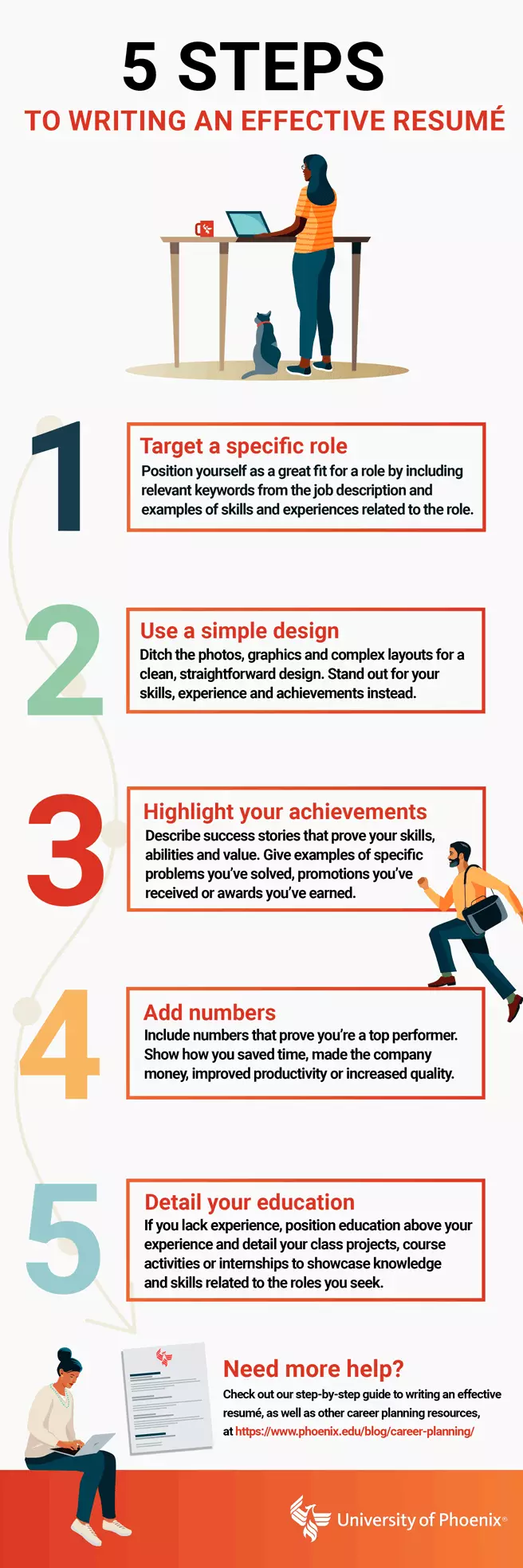

ABOUT THE AUTHOR
Lilia Ortiz is a writer and artist whose creative journey has been shaped by an appreciation for the beauty inherent in the ordinary. She earned her Bachelor of Arts in English literature from Arizona State University in 2013 and a degree in graphic design from Phoenix College in 2018. Her unique approach to visual design intertwines the tangible with the intangible: She weaves together words, thoughts and ideas with texture, color and pattern. Each result is a testament to the storytelling possibilities that emerge from the convergence of literary and visual arts. She lives in Buckeye, Arizona with her husband, Adam, and dog, Pinto.

ABOUT THE REVIEWER
Jessica Roper, University of Phoenix director of Career Services, is a seasoned leader with over 15 years of experience in leadership within higher education. She has honed her expertise in student services and career development and is passionate about helping others discover and refine their skills.
This article has been vetted by University of Phoenix's editorial advisory committee.
Read more about our editorial process.

